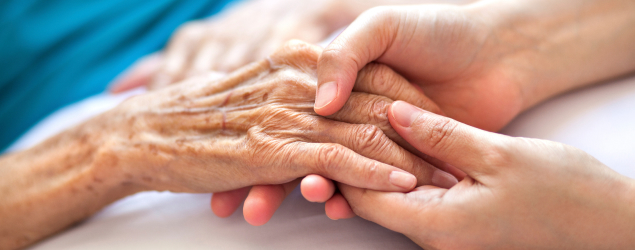Bedsores should be treated under the supervision of a doctor or nurse, topically, i.e. the wound should be secured with appropriate dressings

Above all, under the supervision of a doctor or nurse.
Bedsores should be treated topically, i.e. the wound should be secured with appropriate dressings.
Another important element of treatment is appropriate patient care, which includes:
The topical treatment of bedsores involves the use of dressings specifically designed for this purpose, so-called specialised or modern dressings that create a moist healing environment in the wound.
BLACK WOUNDS
Wounds with black necrosis require:
The healing process will not occur under thick layers of necrotic tissue, and in order to trigger the healing process, the necrosis must first be removed. We have two basic choices for removing necrosis from the wound bed:
Dressings recommended for black wounds:
YELLOW WOUNDS
Wounds with yellow colliquative necrotic tissue require:
Wounds with colliquative necrosis are characterised by an increased degree of secretion. The necrotic tissue remaining at the bottom of the wound is fluid. Such wounds provide an ideal environment for the growth of microorganisms, and are therefore often infected. The role of the dressing in this case is to absorb exudate and necrotic material, liquefying necrosis that is too dry and compacted, not allowing the wound to dry out, and protecting it from secondary trauma.
Appropriate dressings for yellow wounds, depending on the amount of exudate and wound depth:
RED WOUNDS
with visible granulation tissue require:
In addition to maintaining the moist environment, this type of wound also requires protection from possible mechanical trauma. This is particularly important because well-vascularised granulation tissue is susceptible to traumas that delay healing and can cause infection. Another important factor is to maintain an adequate temperature close to body temperature, so that new cells can develop at an optimal rate.
Dressings appropriate for red wounds, depending on amount of exudate and wound depth:
PINK WOUNDS
Pink epithelialising wounds require:
When a wound begins to develop epidermis, it needs protection from drying out, friction and other factors that can damage the newly formed tissue.
Dressings appropriate for pink wounds, depending on the amount of exudate:
INFECTED WOUNDS
Wounds of varying degrees of severity, infected or at risk of infection, protection against infection, inhibition of infection development.
To initiate the healing process, it is necessary to stop the ongoing infection or prevent the wound from becoming infected. Bacterial proliferation triggers cell breakdown, which significantly delays the healing process.
Dressings appropriate for this type of wounds:
Analysis of the phases of healing shows that wounds in various stages of healing require slightly different conditions for the process to proceed smoothly. It should be remembered that in addition to different stages of healing, wounds also differ depending on their extent, depth, presence of necrotic tissue and degree of secretion.
All of these features make it necessary to choose the appropriate type of dressing for each wound, and sometimes several dressings that will be changed during the healing process.
The table below shows factors that can slow down the process of wound healing.
| slowing factor | why | optimal conditions | how it works under optimal conditions |
| dry environment | moist environment | adequate level of exudate in the wound allows activation of natural wound cleaning process accelerates granulation ensures quick and normal epithelialisation |
|
| necrotic tissues | wound healing is only possible after removal of dead tissue, necrosis can be a source of infection |
wound debridement surgical autolytic |
a cleaned wound allows the granulation phase to begin |
| infection | all mechanisms in the wound work to eradicate the intruder, the healing process is inhibited | fight infection | a cleaned wound allows the healing process to begin |